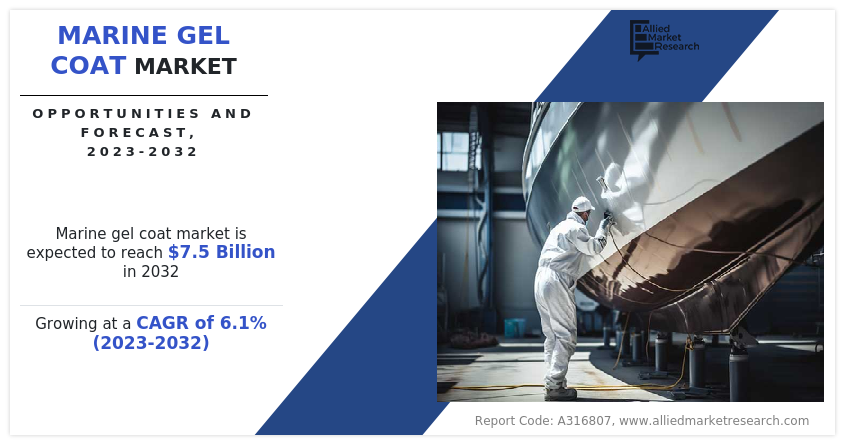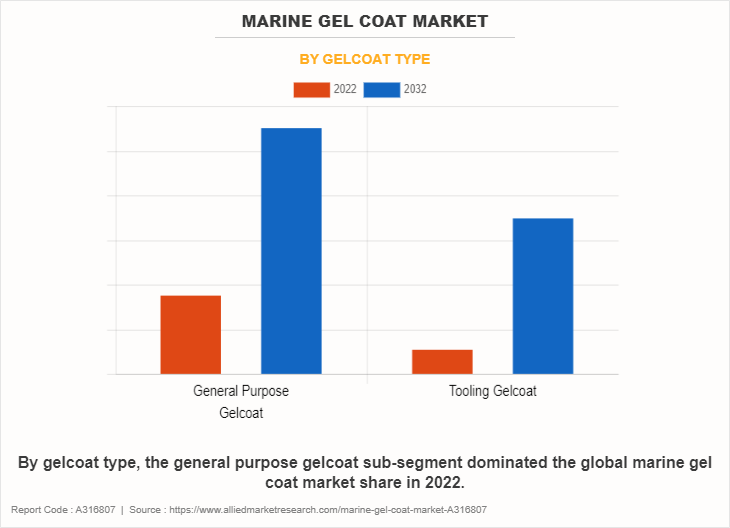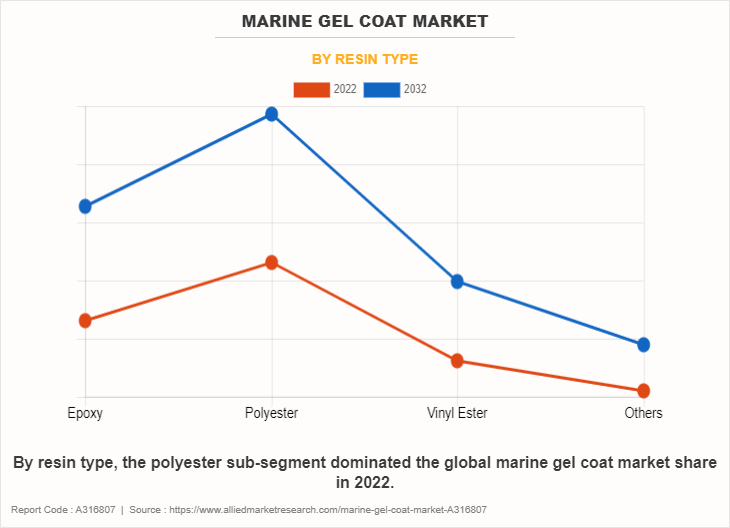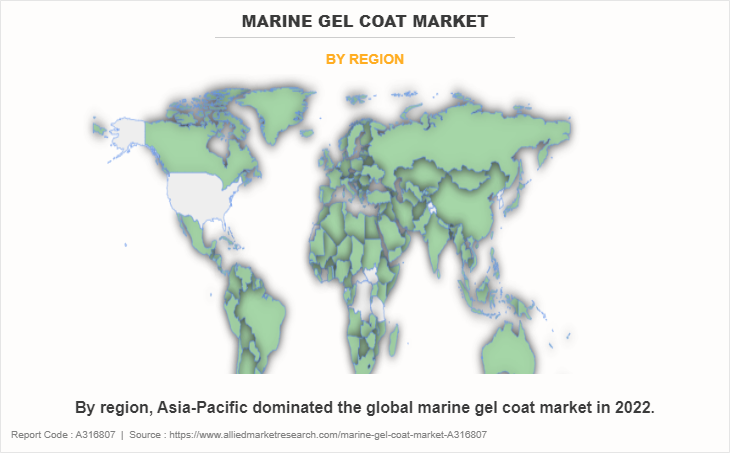Marine Gel Coat Market Research, 2032
The global marine gel coat market size was valued at $4.2 billion in 2022, and is projected to reach $7.5 billion by 2032, growing at a CAGR of 6.1% from 2023 to 2032. Marine gel coat is a specialized substance used in the construction and maintenance of watercraft, known for its multifunctional utility in delivering both protection and cosmetic benefits. Gel coat is the outermost coating of fiberglass-reinforced composites used in boat hulls, decks, and other marine components. It is made mostly of polyester resin that has been infused with colors and additives. Its recipe combines endurance, weather resistance, and a glossy finish, making it essential for the nautical sector. Marine gel coat acts as a shield, protecting boats from the constant onslaught of marine elements. Its impermeable nature creates a powerful barrier, effectively protecting the underlying fiberglass substrate from moisture penetration, osmotic blistering, and UV-induced damage. This protective coating serves as a first line of defense, maintaining boat structural integrity even in the worst maritime situations, such as saltwater corrosion and freshwater abrasion.
Highlights of the Report:
- The report provides exclusive and comprehensive analysis of the global marine gel coat market trends along with the marine gel coat market forecast.
- The report elucidates the marine gel coat market opportunity along with key drivers, and restraints of the market. It is a compilation of detailed information, inputs from industry participants and industry experts across the value chain, and quantitative and qualitative assessment by industry analysts.
- Porter’s five forces analysis helps analyze the potential of the buyers & suppliers and the competitive scenario of the market for strategy building.
- The report entailing the marine gel coat market analysis maps the qualitative sway of various industry factors on market segments as well as geographies.
- The data in this report aims on market dynamics, trends, and developments affecting the marine gel coat market growth.

The major factor driving the use of marine gel coat is its high corrosion resistance. In the severe maritime environment, where boats are continually exposed to seawater and other corrosive substances, safeguarding the underlying fiberglass structure is critical. Gel coat creates a strong barrier that protects fiberglass from corrosion caused by salt, water, UV radiation, and other environmental variables, extending the life of maritime boats and structures. Beyond its cosmetic benefits, marine gel coat protects the fiberglass surface against scratches, abrasions, and impact damage. Whether navigating through rocky coastlines or meeting debris in the sea, the robust covering helps prevent structural damage and preserves the vessel's surface over time. Marine locations expose ships to a range of weather extremes., such as high humidity, harsh sunshine, and temperature changes. Gel coat is extremely weather resistant, withstanding yellowing, fading, and deterioration caused by extended UV exposure and air moisture. This toughness guarantees that the vessel's beauty stays vivid and pristine even after years of exposure to adverse weather conditions. Marine gel coat's adaptability enables vessel customizations and innovation. Gel coat is available in a variety of colors, finishes, and compositions, allowing it to be adapted to individual aesthetic preferences and performance needs. Whether user wants a high-gloss finish for a luxury yacht or a non-skid texture for a fishing boat deck, gel coat provides a variety of design possibilities to suit a wide range of applications.
The application technique for marine gel coat is one of the major limitations. Applying gel coat demands thorough attention to detail, adequate airflow, and perfect time. Any variation from the required application conditions might cause flaws like air bubbles, orange peel texture, or inadequate curing, resulting in impaired aesthetics and durability. Furthermore, the viscosity of gel coat presents difficulties during application, necessitating careful modification to achieve optimum flow and coverage, especially on complicated surfaces or intricate molds. The requirement for expert labor and specialized equipment increases the complexity and cost of the application process, making it less accessible to DIY enthusiasts and small-scale boat owners. Furthermore, the gel coat's vulnerability to external variables provides a considerable drawback. UV exposure, salinity, and extreme weather conditions can cause deterioration and discoloration over time. Despite the use of UV inhibitors and other protective chemicals, marine gel coat may nevertheless exhibit color fading, chalking, or yellowing, particularly in areas with high UV intensity. This not only reduces the boat's aesthetic attractiveness, but also impairs its protective role, potentially exposing the underlying substrate to corrosion or structural damage.
The worldwide recreational boating business is expanding rapidly, driven by rising disposable incomes, increasing tourism activities, and a growing interest in leisure hobbies. Marine gel coat is critical for maintaining and keeping the beauty of leisure boats, yachts, and sailboats, creating a significant potential for manufacturers and suppliers in the marine gel coat industry. As the number of boats and watercraft in operation increases, so does the demand for maintenance, repair, and refurbishing services. Marine gel coat is widely used in these operations to restore scratches, chipping, and other surface flaws while also providing a new, glossy appearance. This creates an opportunity for firms that offer boat repair services and makers of marine gel coat and related products. Ongoing R&D efforts have resulted in the creation of new gel coat formulations that are more durable, weather resistant, and environmentally friendly. Low-VOC (volatile organic compound) formulations, self-healing qualities, and increased adhesion characteristics are allowing producers to better meet the changing demands of boat builders, repair personnel, and boat owners.
Competitive Landscape:
The key players profiled in marine gel coat industry report include Polynt S.p.A., HK Research Corporation, Interplastic Corporation, AkzoNobel, TotalBoat, LLC, Ashland Global Holdings Inc., Scott Bader Company Ltd., AOC, LLC, BUFA GmbH & Co. KG, and Allnex GmbH. Market expansion and acquisition & mergers are common strategies followed by major market players. For instance, on March 9, 2023, PPG Industries launched its SIGMAGLIDE 2390 marine coating. The coating helps shipowners to lower the power consumption and carbon emissions, meeting the demand for higher performance with no adverse impact on the marine environment.
Segment Overview:
The marine gel coat market is segmented on the basis of gelcoat type, resin type, and region. By gelcoat type, the market is divided into general purpose gelcoat and tooling gelcoat. By resin type, the market is classified into epoxy, polyester, vinyl ester, and others. By region, the market is analyzed across North America, Europe, Asia-Pacific, and LAMEA.
The marine gel coat market is segmented into Gelcoat Type and Resin Type.

By gelcoat type, the general purpose gelcoat sub-segment dominated the global marine gel coat market share in 2022. Marine producers and operators need to comply with government requirements and industry norms. General purpose gelcoat formulations are intended to meet or exceed stringent regulatory requirements for fire safety, environmental impact, and performance as established by organizations such as the American Boat and Yacht Council (ABYC) and the International Maritime Organization (IMO). Using certified gelcoat materials allows stakeholders to assure adherence to safety measures while reducing liability risks associated with noncompliance. Despite its various advantages, general purpose gelcoat remains a more cost-effective option for maritime applications than other surface treatments like paint or vinyl wrap. The initial expense of gelcoat application is mitigated by its long-term durability and reduced maintenance needs, which result in lower lifetime costs for boat owners. Furthermore, the availability of low-cost gelcoat choices allows manufacturers to create vessels at reasonable prices while maintaining quality and performance.

By resin type, the polyester sub-segment dominated the global marine gel coat market share in 2022. Polyester has developed as a critical material in the maritime sector, notably in the formulation of gel coatings, due to a number of criteria that demonstrate its appropriateness and efficacy in this specialized application. Polyester's long-standing success in marine gel coatings may be due to its superior qualities and performance attributes, as well as its low cost and simplicity of application. One of the key reasons for the extensive use of polyester in marine gel coatings is its exceptional resistance to corrosion and deterioration in hostile maritime conditions. Furthermore, polyester is extremely versatile in terms of color retention and aesthetic appeal, allowing boat makers to generate brilliant and long-lasting finishes that improve the visual appeal of their goods. The ability of polyester gel coatings to retain their color and gloss over time reduces the need for periodic repainting or refinishing, lowering maintenance costs and increasing the overall value proposition for boat owners.

By region, Asia-Pacific dominated the global marine gel coat market in 2022. The growing demand for recreational boating and watercraft activities is one of the key reasons driving the marine gel coat market growth in Asia-Pacific. Due to increasing disposable incomes, urbanization, and a burgeoning middle class in countries such as China, India, Australia, and South Korea, there has been a noticeable increase in recreational boating activities. The growing interest in maritime leisure has created a need for high-quality gel coat solutions to improve the looks, durability, and performance of boats and yachts, resulting in the regional market growth. In combination with an increase in demand for marine gel coat, technical improvements and developments in gel coating formulas have emerged as key factors driving the growth of the Asia-Pacific marine gel coat market. Manufacturers in the region are constantly investing in R&D to provide next-generation gel coat materials with higher performance features such as increased UV resistance, weatherability, and hydrophobic qualities.
Key Benefits For Stakeholders
- This report provides a quantitative analysis of the market segments, current trends, estimations, and dynamics of the marine gel coat market analysis from 2022 to 2032 to identify the prevailing marine gel coat market opportunities.
- The market research is offered along with information related to key drivers, restraints, and opportunities.
- Porter's five forces analysis highlights the potency of buyers and suppliers to enable stakeholders make profit-oriented business decisions and strengthen their supplier-buyer network.
- In-depth analysis of the marine gel coat market segmentation assists to determine the prevailing market opportunities.
- Major countries in each region are mapped according to their revenue contribution to the global market.
- Market player positioning facilitates benchmarking and provides a clear understanding of the present position of the market players.
- The report includes the analysis of the regional as well as global marine gel coat market trends, key players, market segments, application areas, and market growth strategies.
Marine Gel Coat Market Report Highlights
| Aspects | Details |
| Market Size By 2032 | USD 7.5 billion |
| Growth Rate | CAGR of 6.1% |
| Forecast period | 2022 - 2032 |
| Report Pages | 310 |
| By Gelcoat Type |
|
| By Resin Type |
|
| By Region |
|
| Key Market Players | BUFA GmbH & Co. KG, Ashland Global Holdings Inc., Scott Bader Company Ltd., TotalBoat, LLC, Allnex GmbH, Polynt S.p.A., AOC, LLC, HK Research Corporation, AkzoNobel, Interplastic Corporation |
The marine gel coat market size is expected to grow due to an increase in shipbuilding activities globally. In addition, the market is driven by growth in advancements in gel coat technology.
The major growth strategies adopted by the marine gel coat market players are regional market expansion and acquisition & mergers.
Asia-Pacific will provide more business opportunities for the global marine gel coat market in the future.
Polynt S.p.A., HK Research Corporation, Interplastic Corporation, AkzoNobel, TotalBoat, LLC, Ashland Global Holdings Inc., Scott Bader Company Ltd., AOC, LLC, BUFA GmbH & Co. KG, and Allnex GmbH., are the major players in the marine gel coat market.
The general purpose gelcoat sub-segment of the gelcoat type segment acquired the maximum share of the global marine gel coat market in 2022.
Boat manufacturers are the major customers in the global marine gel coat market.
The report provides an extensive qualitative and quantitative analysis of the current trends and future estimations of the global marine gel coat market from 2022 to 2032 to determine the prevailing opportunities.
Expanding marine transportation and logistics sector is expected to boost adoption of marine gel coat, as marine transportation and logistics companies operates in container ships, bulk carriers, tankers, and cargo vessels which need marine gel coat for hull coating and maintenance.
Sustainable and eco-friendly formulations, antimicrobial and anti-fouling coatings, and surge in demand for lightweight and composite materials to drive the global marine gel coat market.
Loading Table Of Content...
Loading Research Methodology...



